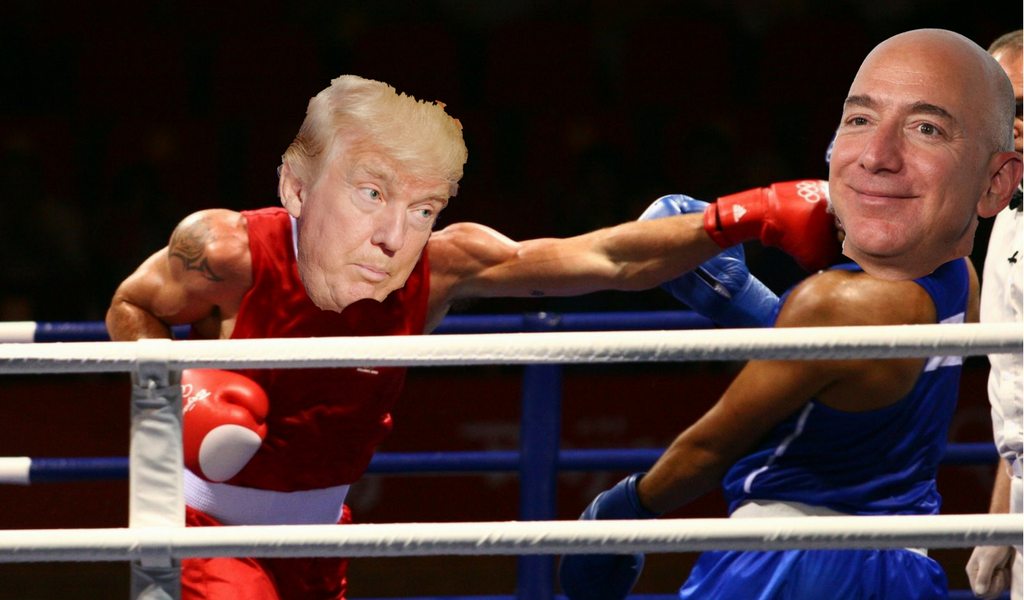
Amazon
OK, it’s happened. I’ve turned into a curmudgeon. A geezer. A galoot. I thought I had a few more years in me before I succumbed, but there you are.
Enough about my problems, though. Let’s talk instead about what I was reading when that conclusion was thrust upon me. It probably won’t have the same effect on you.
In the last moments before I became an old fart, I was reading the annual report 10-K report Amazon filed with the Securities and Exchange Commission (SEC). I was trying to figure out something that’s always puzzled me: Namely, why a smart company like Amazon would willingly take on the punishing economics of food retail.
Groceries are traditionally a lousy business. Margins are down around two or three percent, sometimes worse. If stores couldn’t coax you into overpaying for impulse purchases like batteries and the other stuff they display around the cash registers, they’d have a hard time making ends meet. The ‘zon, meanwhile, has a business model based on low prices and delivery—that is to say, even lower revenue and higher expenses than grocery. How is that supposed to work, exactly? I know technology and scale can do wonderful things, but can they really fix the long-standing problem of low margins in retail?
The short answer: No, of course not.
This isn’t to say that Amazon makes no profits. Its Amazon Web Services division, which provides a huge range of cloud-based services for companies and even governments, has been enormously profitable. In part, it helps replace hardware—you can use Amazon’s servers and network capabilities instead of building your own. But it also offers database tools, analytics, tools for working with media (including streaming media), machine learning, tools for working with the Internet of Things, you name it. Its sales are only a small percentage of what Amazon takes in over a year: just $17.5 billion last year. But its operating margins are terrific, almost 25 percent—which means that the tail earned the dog more than $4.3 billion in 2017.
Here’s the thing: As Vox’s Matt Yglesias explains in this very useful piece, Amazon behaves like a startup—a 20-year-old startup at this point. It plows everything it makes back into growing the business; it doesn’t want profits as much as it wants growth.
How abnormal? Investors typically look at a company’s price/earnings ratio—that is, how many dollars you have to pay for a share of stock for each dollar of profit it makes. A typical P/E ratio is something like 20 or 25. A few companies get up in the range of 100. Last time I looked, Amazon had a P/E of 335. That’s looking backward—to the money it’s already made, which is doubly treacherous with a company that’s throwing all its profits into growth, and growing like gangbusters as a result. But even using projected earnings, it has a PE of 95 or so.
To oversimplify a bit, there are two possible explanations for this. One, Amazon has persuaded investors that it’s onto a good thing, and that if they sit out a long period of no profits, they’re going to be rewarded. Or, two, investors see the way Amazon’s stock has gone up and up on numbers that make no traditional sense, and figure that they might as well join in and enjoy the ride.
 Amazon
Amazon What is Amazon? A retailer? Web service provider? Search provider? Ad company? All of the above? Or are the distinctions truly obsolete?
Who’s right? Who knows. The truth may be a bit of both. Personally, I’m the kind of guy who believes that the old rules mostly apply—and that people who say that some new paradigm makes common sense irrelevant are probably cruising for a bruising. (Remember the dot-com bust?) On the other hand, a company like Amazon is legitimately complex, which makes it hard even to figure out which rules are supposed to apply.
After all, what kind of company is Amazon? If you talk to people in the worlds of food or retail, they’ll probably say it’s a retailer—and one that they don’t like, because it keeps changing the rules of the game, and because of that willingness to take losses. Talk to people in finance or business strategy or tech, and they’re all pretty much agreed that Amazon is a tech company, and that the relevant comparisons are to operations like Google.
Google? We don’t usually think of Amazon as a search engine. But hard-core business analysts tend to lump them together, and with good reason. According to recent research, customers searching for products online turn to Amazon for their first search 49 percent of the time. Search engines including Google come in second, with only 36 percent.
Viewed in this light, the various wings of Amazon’s business make a kind of sense together. Amazon sells services that make it easy for entrepreneurial companies to sell on the web. But because it is itself such a huge seller of products on the web, it dominates product search. And that means that the entrepreneurs who were drawn to the business by AWS’s web services have a powerful incentive to join Amazon’s marketplace, paying fees to have their products listed and to have Amazon manage transactions or maybe even handle logistics and shipping. The fact that more companies are in the marketplace makes it more important for other companies and other product categories to be there. And so the marketplace grows, the product search grows, and Amazon’s control over product-related consumer data grows—which means that its analytics get sharper, and AWS’s services become more valuable, and on and on and on.
So what is Amazon? A retailer? Web service provider? Search provider? Retail aggregator? Market analytics company? Ad company? All of the above? Or are the distinctions truly obsolete?
***
I should point out that none of this makes me feel like a codger. It confuses me. It makes my head hurt. It makes me wonder what fresh disaster awaits us down the road when the unexpected consequences of Amazon’s business strategy finally come to light, and (if we’re unlucky) we realize that “too big to fail” doesn’t apply just to banks. But feeling like that has nothing to do with being a codger. It’s just normal quotidian angst circa 2020. If you share my reaction, get used to it.
But here are two things that do make me feel codgerish:
First, in a world where companies can monetize data about their customers and build big analytic engines, a certain kind of big, tech-oriented company has a permanent advantage over smaller, more traditional competitors. Sure, a regional, family-owned grocery chain can use loyalty cards to collect data about what its customers buy and what price points they’re sensitive to, and so on. But an Amazon can use what it learns in one realm to make predictions about entirely other realms. (There’s famous story about how Target used purchases of things like vitamins and cotton balls and unscented lotions to identify pregnant women in the customer base. People got upset and Target stopped, but it worked, and strategies like it will work again.) That means an Amazon-style company can wring more value out of what it knows, in the form of additional sales, more powerful analytics that can be sold to outside clients, whatever. And the money made off the data can be used to keep prices at a point where the traditional competitors are in pain all the time.
Second, what this all seems to mean is that the companies that we depend on for the things we need to live our lives—food, clothing, books—are increasingly going to be companies that don’t actually see themselves as being in that business. You buy groceries from Amazon? You’ll be buying from a tech business that cares as much about the data it collects on you as it does on the food it sells you, and makes its money somewhere else.
To which Zuckerberg, if he was being frank, would have said: “Hell, no. Facebook is the sum of its members. If you leave, you leave your friends behind, or you have to coax them all to join you somewhere else. It would be a disaster for us if we had to grant continuing access to the network of people to people who don’t belong to the network. It’s why our business is better than the telephone business.
“Besides, Senator, you don’t get it. Those people who use Facebook aren’t our customers at all. They’re our product, and we sell access to them and data about them to our real customers, including those Russians you’re worried about.”
And I really hate that. I hate giving my money to somebody who doesn’t regard me as a customer, or who doesn’t single-mindedly regard me as a customer.
Why not? I don’t entirely know. I kind of like Amazon and Google. I admire the way they’ve learned to build extra economic value into transactions. I use them. But I don’t approve of them. God help me, I find myself thinking things like, “Back in the old days . . .”
Total codgerdom. I know, and I disgust myself. Still, I find myself intellectually stuck. I don’t like the system that we seem certain to use in the future. And I long for the moral flavor (and I doubt that it’s much more than a flavor) of the world we’ve left behind—a world that I truly don’t want to live in anymore.
Is this what it’s like to get old? The rest of you carry on. I need a nap.
And, by the way, get off of my lawn.









